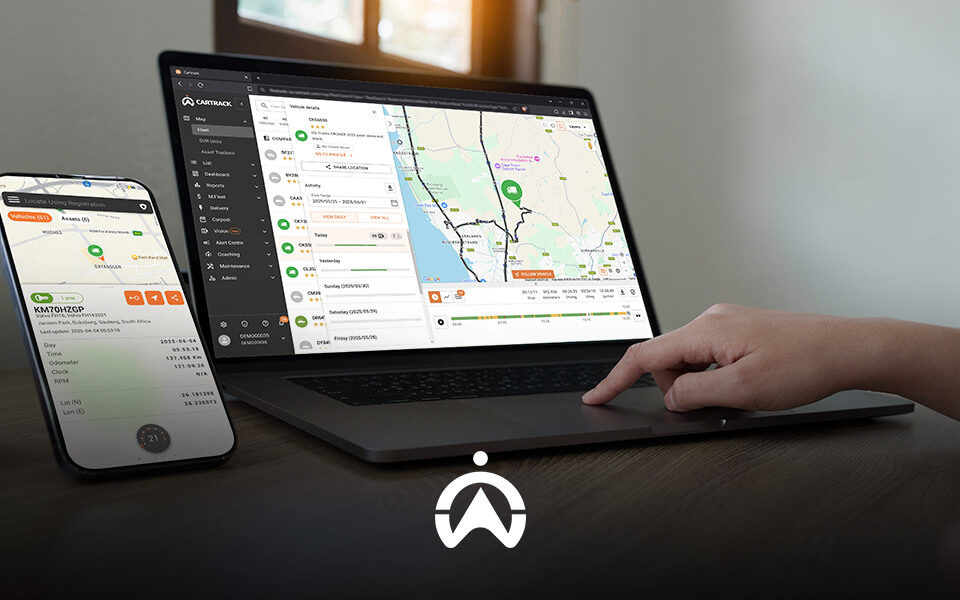AI Takeover: The Truth About the Future of Telematics
Artificial intelligence (AI) has and is transforming vehicle tracking more than we can imagine.
A concept once only seen in sci-fi movies has leapt from our TV screens into everyday reality. As we witness the growth of artificial intelligence, it’s only natural to wonder how this innovation will further influence the use of telematics.
Let’s take a peek into the future of AI in the world of telematics.
In this article, you will:
- Understand the fundamentals of telematics and its role in fleet management
- Explore the rise of AI and its impact on telematics systems
- Learn about the benefits and downsides of AI in the telematics industry
- Discover the potential of telematics and AI technology in everyday tasks
- Uncover your fleet’s true potential with Cartrack Nigeria.
What is telematics?
Telematics in simple terms, combines informatics and telecommunications, making it a powerful tool for gathering and managing data through technology. Today, telematics is used in various industries, including fleet management.
Imagine you’re a fleet manager responsible for a group of vehicles, such as delivery vans or service trucks. You want to make sure your fleet operates smoothly, efficiently, and safely.
Telematics is the best technology to assist with all these tasks.
A telematics system consists of a tracking device installed in each vehicle in your fleet. These devices connect with onboard diagnostics, enabling continuous communication while storing, sending, and receiving telemetry.
Some examples of telemetry data that can be collected by telematics systems include:
- Speed – Records the vehicle’s speed, providing insights into driver behaviour and compliance with speed limits.
- Fuel consumption – Monitors fuel consumption and stores data related to fuel usage, enabling analysis and optimisation of fuel efficiency.
- GPS location – Captures the coordinates of the vehicle’s current or historical positions, allowing for accurate tracking and route analysis.
- Vehicle idling time – Monitors instances of prolonged idling and helps identify inefficiencies. This can assist in reducing fuel consumption and emissions.
- Driver behaviour – Analyse driver behaviour, including harsh acceleration, harsh braking, and harsh cornering, providing data to promote safer driving practices and identify areas for improvement.
- Distance travelled – Calculates and stores the distance travelled by the vehicle, allowing for mileage tracking and maintenance scheduling.
- Engine diagnostics – Monitors engine performance and stores diagnostic data like RPM, engine temperature, fuel levels, and error codes, which aids in troubleshooting and maintenance.
With this data, businesses gain invaluable insights into their fleet’s performance, leading to better decision-making, improved asset utilisation, and significant cost savings.
The rise of artificial intelligence
The future of vehicle tracking is here, driven by the power of AI and telematics. As technology advances, vehicle manufacturers are keeping pace by incorporating super-smart connectivity features that allow their vehicles to interface seamlessly with the AI-powered software designed to monitor and analyse them.
Traditionally, telematics systems collected and transmitted data, but struggled to extract meaningful insights on time. Thanks to the growth of IoT (Internet of Things) and the advancement of machine learning algorithms, AI can process and analyse vast amounts of data instantly, providing valuable information about vehicle performance, driver behaviour, and operational efficiency.
This empowers businesses to make data-driven decisions and take proactive measures to improve their operations.

Six benefits of AI in the telematics industry
So, what makes AI so revolutionary? Well, with easily accessible fleet data, comes swift decision-making and a more hands-on approach to managing.
Let’s explore six more key reasons why AI is a fleet manager’s dream assistant:
- Enhanced safety and accident prevention: AI automation in telematics offers real-time feedback to drivers, helping prevent potential accidents. By analysing data, AI can identify risky driver behaviour, provide coaching and feedback, predict risks in route planning, and address safety concerns before they result in costly errors. Automated workflows can also monitor fuel usage and suggest actions to reduce it, contributing to a business’s overall sustainability goals.
- Actionable insights through data analysis: AI technology with machine learning capabilities allow for analysing of data collected by telematics systems. By identifying patterns and trends, fleet operators can make intelligent decisions and improve operational processes. AI-powered insights provide valuable information about driver behaviour, fuel usage, safety issues, and maintenance, leading to better cost management and increased efficiency.
- Predictive analytics for proactive management: AI and advanced analytics enable a shift from reactive decision-making to proactive management policies. By leveraging big data, fleet managers can anticipate problems before they become obstacles to operations. Predictive analytics can help reduce costs, improve maintenance, increase efficiency, and promote better driver behaviour, resulting in financial benefits for the organisation.
- Improved driver behaviour and performance: AI technology can effectively monitor and enhance driver behaviour. By providing continuous feedback and reinforcement of safe driving habits, fleet managers can ensure that drivers practise responsible behaviour on the road. This leads to increased safety, reduced accidents, and improved overall fleet performance.
- Optimal safety measures: AI technology introduces advanced techniques such as driver behaviour and identification, alarm systems, and geofencing to enhance fleet safety. Real-time monitoring systems enable fleet managers to receive instant notifications and respond swiftly to emergencies. Comprehensive reports generated by AI-powered systems help identify safety deficiencies and facilitate corrective actions, ensuring the safety of the fleet and its drivers.
- Strengthened data security: As fleets handle large volumes of sensitive data, data security is crucial. In the telematics industry, there is a growing emphasis on increased cybersecurity measures and the adoption of integrated databases. Fleet operators prioritise protecting sensitive information and are investing in strategic management approaches and upskilling IT personnel to meet evolving cybersecurity challenges.
Six downsides of AI-driven telematics
While AI in telematics brings the above-mentioned benefits and many more, there are some challenges that need to be addressed:
- Ethical and regulatory concerns: The use of AI algorithms raises ethical considerations regarding transparency and accountability. Clear guidelines and regulations are required to ensure ethical standards are upheld and individuals’ rights are protected.
- Data privacy and security: Telematics involves collecting and transmitting vast amounts of data, including personal and sensitive information. Ensuring data privacy and security is crucial to protecting against potential misuse or unauthorised access. Robust encryption, authentication mechanisms, and adherence to data protection regulations are essential.
- Bias and discrimination: AI algorithms are trained on data, and if the training data contains biases, it can lead to discriminatory outcomes. Biassed algorithms may affect areas such as driver behaviour assessment, insurance premium calculations, and personalised user experiences. Efforts must be made to minimise biases, ensure diverse and representative training data, and implement fairness measures in AI models.
- Integration and compatibility: Integrating AI technologies with existing telematics infrastructure can bring up technical challenges. Compatibility and smooth integration with diverse hardware and software components need to be ensured.
- Skill gaps and workforce training: The increasing reliance on AI demands a skilled workforce capable of developing, implementing, and maintaining AI systems. Organisations must invest in training programs and upskilling initiatives to bridge the skill gaps and empower employees to work effectively with AI technologies.
- Cost and resource requirements: AI implementation in telematics may involve substantial costs, including hardware upgrades, software development, and ongoing maintenance. Organisations must carefully assess the return on investment and consider long-term sustainability to justify the expenses associated with AI adoption.
Despite the challenges, AI in telematics still holds immense potential. It empowers transportation, logistics, and various other industries to unlock actionable insights, optimise operations, enhance safety, and create personalised user experiences.
How do telematics and AI technology help fleet managers?
Simplifying tasks, streamlining operations and cutting down on fleet costs are always top priorities for fleet managers.
Let’s see how telematics can become your right-hand man in your quest to get those daily tasks done and dusted quicker.
Say you’re interested in monitoring fuel consumption across your fleet, one of your most costly responsibilities. With telematics, you can track this data in real time. You’ll know which vehicles are efficient and which ones may need attention. This insight allows you to take proactive steps, such as addressing maintenance issues or providing driver training, to improve fuel efficiency and save costs.
If you want to focus more on improving driver safety, telematics also provides valuable information about driver behaviour. It can track factors like speed, harsh braking, and idling time. As a fleet manager, you can use this data to identify risky driving patterns and take appropriate measures to improve safety. For example, if you notice excessive speeding, you can offer training programs or implement driver rewards for safe and responsible driving.
The possibilities are vast with the combination of AI and telematics. AI algorithms can process telematics data in real-time, enabling predictive modelling, intelligent analytics, and personalised experiences.

How AI-powered solutions will shape the future of fleets
Traditional fleet management systems are making room for a new wave of AI-powered solutions, ushering in a transformative era for fleet management practices. These innovations can unlock new levels of efficiency, safety, and sustainability in the transportation industry.
- The prominence of Mobility-as-a-Service (MaaS)
Initially focused on ride-sharing platforms like Uber, MaaS is now extending its reach to include traditional fleet operations with services like Uber Eats and Courier Butler to enter a $22.18 billion estimated market by 2028.
Considered the future of mobility, Mobility-as-a-Service allows fleet managers to customise their services and move away from the conventional approach of solely operating and maintaining their own vehicles.
By leveraging AI and telematics data, fleets can seamlessly integrate with MaaS platforms, offering end-to-end multimodal transportation services. This integration optimises passenger experiences, improves overall mobility efficiency, and enables fleet managers to explore new business models and revenue streams.
- The impact of the Internet of Things (IoT) One of the most popular trends in telematics is the Internet of Things (IoT). It enables the re-engineering of the entire supply chain process by promoting the seamless sharing of information between all stakeholders, such as retailers and manufacturers, and connecting physical vehicles, devices, and sensors with the digital world.
With IoT and AI-powered telematics systems, fleet managers can now collect real-time data, enabling fleet operators to monitor tyre pressure, monitor refrigerated systems and track vehicle performance.
How does this work?
IoT technology in fleet management relies on three key technologies:
– Wireless communication: This includes technologies like 4G, Bluetooth, and WiFi, which help transmit important information between vehicles and systems.
– Global positioning system (GPS): GPS enables accurate real-time tracking of vehicle locations, allowing for precise monitoring and control.
– Onboard diagnostics: Vehicles use diagnostic tools like OBDII and J1939 scanners to perform self-diagnostics and report any issues, making maintenance and troubleshooting easier.
So, it’s not just about keeping up with the latest tech — it’s about seizing the opportunities it brings. By embracing these advancements and leveraging the power of data, businesses can gain a competitive edge, deliver exceptional customer experiences, and propel themselves forward in the dynamic business landscape.

Empower your fleet with Cartrack’s advanced telematics solutions
As the future of telematics and AI unfolds, businesses must prepare for a new era of fleet management. Cartrack Nigeria strives to deliver innovative technology to help businesses track, manage and improve their fleet.
Cartrack Nigeria offers a suite of telematics solutions designed to streamline operations with robust tracking devices and sophisticated software like:
- Advanced telematics technology: With installed tracking units and a smart fleet management platform, Cartrack Nigeria enables fleet managers to monitor their vehicles’ location, performance, and driver behaviour in real-time.
- Predictive maintenance: Cartrack’s telematics and AI solutions enable Cartrack to predict maintenance needs before breakdowns occur. This proactive approach minimises downtime, reduces repair costs, and improves fleet reliability. Businesses can now optimise their maintenance schedules, enhance vehicle longevity, and maximise operational efficiency.
- Seamless integration with IoT and MaaS: Cartrack’s technology can seamlessly integrate with these technological innovations as well as vehicle advancements like electric vehicles. Fusing telematics, AI, and IoT, allows fleet managers to access fleet data like location, diagnostics, fuel monitoring and much more, to optimise passenger experiences, and explore new business models.
- Enhanced safety and compliance: Cartrack Nigeria provides solutions to ensure fleet safety and compliance with features such as vehicle reports and logbooks. Cartrack Nigeria ensures roadworthy vehicles and regulatory compliance with over 40 reports to monitor driver behaviour and optimise fleet performance. Cartrack’s logbook automatically logs all car trips and categorises them as personal or business trips ensuring you have a tax-compliant logbook ready for SARS submissions. Businesses can also benefit from simplifying compliance management by seamlessly handling insurance, permits, contracts, and other compliance obligations all from one platform.
Discover how Cartrack Nigeria can transform your fleet management and propel your business forward.
Lead the change with Cartrack Nigeria
The future of telematics is evolving right before our eyes and Cartrack Nigeria is leading the charge. Businesses have long struggled to upload large amounts of data captured by their telematics systems, limiting the use of data and diminishing the return on investment.
Contact Cartrack Nigeria today to discover how our AI-powered telematics solutions can help you unlock the true potential of your fleet.



